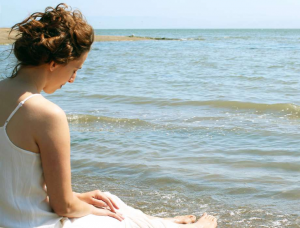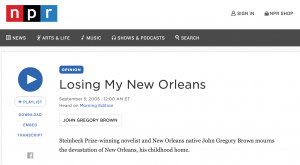In short, Mrs. Pontellier was not a mother-woman. The mother-women seemed to prevail that summer at Grand Isle. It was easy to know them, fluttering about with extended, protecting wings when any harm, real or imaginary, threatened their precious brood. They were women who idolized their children, worshiped their husbands, and esteemed it a holy privilege to efface themselves as individuals and grow wings as ministering angels.
Though not a mother-woman, and not fitting of most common turn-of-the-century characteristics of a married woman, Edna Pontellier is an incredibly sensitive and complex character. It is interesting to see the ways in which she remains, for the most part, emotionally detached from her husband and children (save a few outbursts of affection), while at the same time she performs, physically, the role of mother, housewife, and socialite. The first interaction between Mr. and Mrs. Pontellier, in which Mr. Pontellier regards his wife “as one looks at a valuable piece of personal property which has suffered some damage,” (Chopin, 3), Edna does not speak. She simply holds up her hands in question and waits for her husband to return her rings. I found it interesting that she remained quiet until he gave her back the jewelry, which likely included her wedding ring, that could symbolize his ownership and control over her, and thus his permission for her to speak. I thought this could also be a symbol of the relationship between the pair and how it represents Edna’s complacency, in the beginning, with her situation; she is confined to the role that her husband has designated her and though she may set it aside for a little while, to go swimming or walking down the beach, she never fully leaves it behind.
The Pontellier children are not mentioned until page 3 when they are described as belonging to Mr. Pontellier: “Mr. Pontellier’s two children were there–sturdy little fellows of four and five.” Their introduction is brief and provides little insight as to what the children are like. Their names are not given for several pages. Throughout the novel, the boys often fall to the back of Edna’s mind, forgotten, until they move suddenly or cry out for her. “She was fond of her children in an uneven, impulsive way. She would sometimes gather them passionately to her heart; she would sometimes forget them… Feeling secure regarding their happiness and welfare, she did not miss them except with an occasional intense longing. Their absence was a sort of relief, though she did not admit this, even to herself. It seemed to free her of a responsibility which she had blindly assumed and for which Fate had not fitted her,” (Chopin, 28). This passage revealed to me an emotional disconnect between Edna and the rest of her world, a streak of tenacity that is seen several times more. She explains to Madame Ratignolle, on page 72, “I would give up the unessential; I would give my money, I would give my life for my children; but I wouldn’t give myself.” Though it became evident, to me at least, later in the novel that Mrs. Pontellier suffered from mental illness that caused her to experience manic-like symptoms, which seem to make her question several aspects of her existence, she does not falter from this belief of her self, or from her unwillingness to part with it.
As she becomes more independent and self-actualized, Edna becomes more resistant to the physical roles and duties that she once performed. When she wishes to lay outside, in the hammock, and her husband presses her to come in the house, she grows angry. “She perceived that her will had blazed up, stubborn and resistant. She could not at that moment have done other than denied and resisted. She wondered if her husband had ever spoken to her like that before, and if she had submitted to his command. Of course she had; she remembered that she had. But she could not realize why or how she should have yielded, feeling as she then did,” (Chopin, 47). Later in the novel, when Edna’s father comes to visit and witnesses a scene of her resistance towards her husband, he tells Mr. Pontellier, “You are too lenient, too lenient by far, Leonce… Authority, coercion are what is needed. Put your foot down good and hard; the only way to manage a wife. Take my word for it,” (Chopin, 109). It is interesting to me, how men’s perspectives are performed in this novel because they seem so outdated but there are still many men who would agree with Mr. Pontellier and his wife’s father, though perhaps they wouldn’t phrase it so bluntly.
The poignancy of this novel is not in how it differs from today’s societal expectations of women, but how it aligns with them: women are often expected to fulfill womanly duties; manage their households, their husbands, their jobs, and of course to be beautiful, and thin (but never too thin) and yet to have curves (but never too many). We are expected to be feminine but never show too much emotion, encouraged to be the “boss” but never more so than our male counterparts, for fear of giving offense. Edna Pontellier saw and felt all of these expectations when she was awakened, but it seems to me that she did not know how to cope with the weight of them; she could not know what she did and still perform her duties for her children and husband and friends without sacrificing her self. Though not explicitly written on the page, it is likely that her newfound knowledge and unwillingness to sacrifice drove her to suicide. On page 177, as she swims towards the horizon, one of the last of her thoughts is one of defiance: “They were a part of her life. But they need not have thought that they could possess her, body and soul.” There is also the idea that she knew the repercussions of her actions, and how they would affect her family. More specifically, how they would affect her children. As she mentioned several times, she was always willing to sacrifice her life and material possessions for her sons, just not herself, so it would make sense that in order to protect them from her actions, and not sacrifice the only thing that she wasn’t willing to give up for them, she would give her life for them. I know that the text never explicitly states Edna died, but I find it interesting that where suicide (even if only implied), is usually considered a selfish action, in Edna’s case it was possibly the most selfless thing she could have done, given the societal expectations of the time, but still served her purposes. I think that is what makes the final scene of The Awakening so interesting; the tension between her selfishness and her selflessness.


